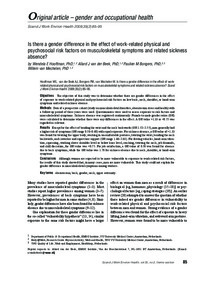Is there a gender difference in the effect of work-related physical and psychosocial risk factors on musculoskeletal symptoms and related sickness absence?

Hooftman, Wendela E. ; van der Beek, Allard J. ; Bongers, Paulien M. ; van Mechelen, Willem
Scandinavian Journal of Work, Environment and Health
2009
35
2
85-95
back disorders ; neck disorders ; upper extremity disorders ; absenteeism ; sick leave ; occupation disease relation ; physical workload ; psychosocial risks ; gender
Musculoskeletal disorders (MSD)
http://dx.doi.org/10.5271/sjweh.1316
English
Bibliogr.;Ill.
"OBJECTIVES:
The objective of this study was to determine whether there are gender differences in the effect of exposure to work-related physical and psychosocial risk factors on low back, neck, shoulder, or hand-arm symptoms and related sickness absence.
METHODS:
Data of a prospective cohort (study on musculoskeletal disorders, absenteeism stress and health) with a follow-up period of three years were used. Questionnaires were used to assess exposure to risk factors and musculoskeletal symptoms. Sickness absence was registered continuously. Female-to-male gender ratios (GR) were calculated to determine whether there were any differences in the effect. A GR value >1.33 or <0.75 was regarded as relevant.
RESULTS:
Except for the effect of bending the wrist and the neck backwards (GR 1.52-2.55), men generally had a higher risk of symptoms (GR range 0.50-0.68) with equal exposure. For sickness absence, a GR value of >1.33 was found for twisting the upper body, working in uncomfortable postures, twisting the wrist, bending the neck backwards, and coworker and supervisor support (GR range 1.66-2.63). For driving vehicles, hand-arm vibration, squeezing, working above shoulder level or below knee level, reaching, twisting the neck, job demands, and skill discretion, the GR value was <0.75. For job satisfaction, a GR value of 0.50 was found for absence due to back symptoms, while the GR value was 1.78 for sickness absence due to neck, shoulder, or hand-arm symptoms.
CONCLUSIONS:
Although women are expected to be more vulnerable to exposure to work-related risk factors, the results of this study show that, in many cases, men are more vulnerable. This study could not explain the gender difference in musculoskeletal symptoms among workers."
Digital
The ETUI is co-funded by the European Union. Views and opinions expressed are however those of the author(s) only and do not necessarily reflect those of the European Union or the ETUI.